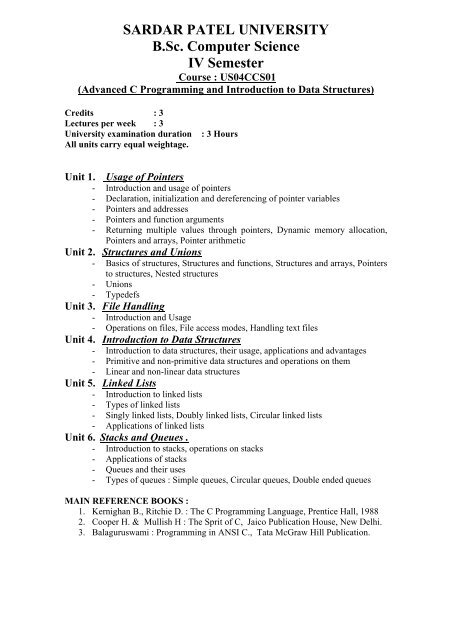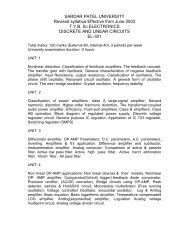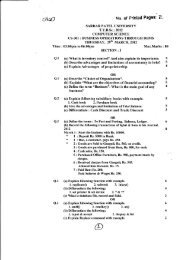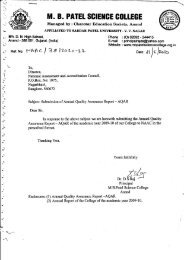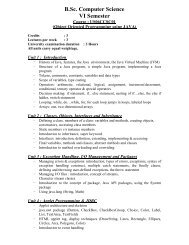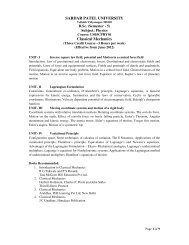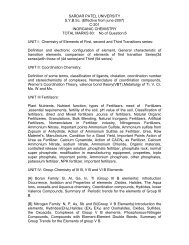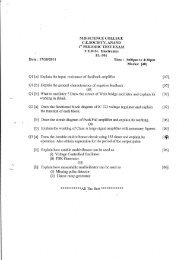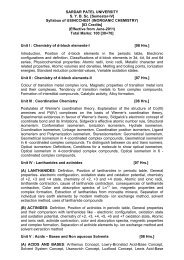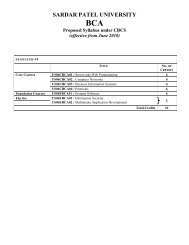SARDAR PATEL UNIVERSITY B.Sc. Computer Science IV Semester
SARDAR PATEL UNIVERSITY B.Sc. Computer Science IV Semester
SARDAR PATEL UNIVERSITY B.Sc. Computer Science IV Semester
You also want an ePaper? Increase the reach of your titles
YUMPU automatically turns print PDFs into web optimized ePapers that Google loves.
<strong>SARDAR</strong> <strong>PATEL</strong> <strong>UN<strong>IV</strong>ERSITY</strong>B.<strong>Sc</strong>. <strong>Computer</strong> <strong>Sc</strong>ience<strong>IV</strong> <strong>Semester</strong>Course : US04CCS01(Advanced C Programming and Introduction to Data Structures)Credits : 3Lectures per week : 3University examination durationAll units carry equal weightage.: 3 HoursUnit 1. Usage of Pointers- Introduction and usage of pointers- Declaration, initialization and dereferencing of pointer variables- Pointers and addresses- Pointers and function arguments- Returning multiple values through pointers, Dynamic memory allocation,Pointers and arrays, Pointer arithmeticUnit 2. Structures and Unions- Basics of structures, Structures and functions, Structures and arrays, Pointersto structures, Nested structures- Unions- TypedefsUnit 3. File Handling- Introduction and Usage- Operations on files, File access modes, Handling text filesUnit 4. Introduction to Data Structures- Introduction to data structures, their usage, applications and advantages- Primitive and non-primitive data structures and operations on them- Linear and non-linear data structuresUnit 5. Linked Lists- Introduction to linked lists- Types of linked lists- Singly linked lists, Doubly linked lists, Circular linked lists- Applications of linked listsUnit 6. Stacks and Queues .- Introduction to stacks, operations on stacks- Applications of stacks- Queues and their uses- Types of queues : Simple queues, Circular queues, Double ended queuesMAIN REFERENCE BOOKS :1. Kernighan B., Ritchie D. : The C Programming Language, Prentice Hall, 19882. Cooper H. & Mullish H : The Sprit of C, Jaico Publication House, New Delhi.3. Balaguruswami : Programming in ANSI C., Tata McGraw Hill Publication.
Course : US04CCS02( Operating Systems )Credits : 3Lectures per week : 3University examination durationAll units carry equal weightage.: 3 HoursUnit 1. Introduction− Introduction to Operating System− Functions of OS− Different types of Operating Systems: Real time, Multi-user, Time sharing− OS Structure – Monolithic, Layered, Virtual Machine, Client-ServerUnit 2. I/O Management− I/O Devices− Organization of the I/O function− Operating System design issues− I/O BufferingUnit 3. <strong>Sc</strong>heduling− CPU <strong>Sc</strong>heduling: Introduction to process, process control block, processscheduling− FCFS <strong>Sc</strong>heduling, SJF scheduling, Priority scheduling, Round Robin schedulingUnit 4. Memory Management-I- Concept- Logical Vs physical address space- Swapping- Contiguous allocation- Paging- SegmentationUnit 5. Memory Management-II- Virtual Memory System- Demand Paging- Page replacement algorithms:a) The Optimal Page Replacement Algorithmb) The LRU Page Replacement Algorithmc) The FIFO Page Replacement Algorithmd) The second change Page Replacement Algorithme) The clock Page Replacement AlgorithmUnit 6. Process Synchronization and Deadlocks- Introduction to Cooperating process− Process Synchronization,− Critical Section Problem− Two process solution, Multiple process solution− Deadlock and characterization
MAIN REFERENCE BOOKS:1. Andrew S. Tanenbaum: Operating System deign & Implementation, Prentice HallInternational.2. James Peterson and Abraham Silberschatz: Operating System Concept, AdditionWesley.3. William Stallings : Operating Systems, Prentice Hall India, Second Edition.
Course : US04CCS03(Practicals)Credits : 3No. of laboratory hours per week : 6University examination duration: 3 HoursPractical Based on US04CCS01.
Course : US04ECS01(Basics of Linux Operating Systems)Credits : 2Lectures per week : 2University examination durationAll units carry equal weightage.: 2 HoursUnit 1. LINUX System- Introduction to Linux System & History- Features of Linux- Design principles- Introduction to File SystemUnit 2. Process and Memory management- Process management Fork/Exec process model Process and threads− <strong>Sc</strong>heduling Kernel synchronization− Memory management Management of physical memory Virtual memoryUnit 3. Basic Commands− login, logout, date, cal, man, pwd, who, who am i, dir, ls, cd, mkdir, rmdir− Use of Wild card characters and introduction to vi editor− Introduction to environment variable like HOME, PATH, PS1− Types of FAP, use of chmod command− Basic commands like cp, mv, rm, rev, file redirection− Grep, cut, paste, find sort commands with exampleUnit 4. Introduction to Shell <strong>Sc</strong>ripting- Introduction to shell script: execution of it, shell script variable, expr, testcommands- Control structure: if, if..else, case structure- Iteration: while, for construct, break, continue, exit commands-MAIN REFERENCE BOOKS :1. Andrew S. Tanenbaum: Operating System deign & Implementation,Prentice Hall International2. James Peterson and Abraham Silberschatz: Operating System Concept,Addition Wesley3. Linux Commands Instant reference – Bryan Pfaffenberger BPBPublication4. Advanced Linux Programming – Samuel, Techmedia Publications
Course : US04ECS02( RDBMS for small scale organization )Credits : 2Lectures per week : 2University examination durationAll units carry equal weightage.: 2 HoursUnit 1. Introduction to the RDBMS Package- RDBMS for small scale organizations – Introduction and applications- Working with menus, toolbars and other components- Working with databases – creation and saving- Creating a table objectUnit 2. Working with Data Operations and Establishing Relationships- Inserting data into tables- Operations on data – adding, deleting, editing, sorting, etc.- Creating a primary key- Creating Relationship between tablesUnit 3. Working with Queries, Forms and Reports- Working with Query – creation, editing, saving, specifying criteria, multipletablequeries, different types of queries- Using forms and reports – creating, modifying, saving, etc.- Using AutoForm, AutoReportUnit 4. Using Miscellaneous Features- Creating mailing labels and charts- Data Import and Export facility- Database security- Database utilities- Overview of macros and modulesMAIN REFERENCE BOOKS :1. Virginia Andersen : Microsoft Office Access 2003 : The complete reference,McGraw Hill, 20032. Progue, Irwin, Roardon : Microsoft Office Access 2003 Bible, Wiley PublishingInc., 20043. Manuals of relevant software packages
Course : US04ECS03( Information Technology in Business)Credits : 2Lectures per week : 2University examination durationAll units carry equal weightage.: 2 HoursUnit 1. Introduction to Information Systems - I- Categories of information, the data pyramid- Information systems and technologies- Importance of information systems in businesses- Information system activities – input, processing, output, storage, control ofsystem performanceUnit 2. Introduction to Information Systems - II- Components of an information system- Information system resources – people, hardware, software, data, network- Gaining strategic advantage through IT- Managerial Challenges of ITUnit 3. Functional Business Systems- An introduction to information systems for manufacturing, marketing,accounting, human resources management, financial management, inventorymanagement, etc.Unit 4. Introduction to Enterprise Applications- An introduction to Enterprise Resource Planning, Customer RelationshipManagement, Supply Chain Management, E-commerce systemsMAIN REFERENCE BOOKS :1. O’Brien J. : Management Information Systems, Tata McGraw-Hill, 20042. Jessup L., Valacich J. : Information Systems Today – Why IS Matters, PearsonEducation, 2006


